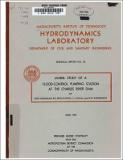Model Study of a Flood-control Pumping Station at the Charles River Dam
Author(s)
Harleman, D. R. F.; Broughton, R. S.; Huval, C. J.; Partenscky, H. W.
Download13884019.pdf (8.932Mb)
Metadata
Show full item recordAbstract
This report describes the design, construction and testing of a Froudian model of a proposed 8400-cfs capacity pumping station, Site restrictions require that the flow approach the high specific-speed pumps asymmetrically from an existing ship lock through the Charles River Dam (Boston, Massachusetts). The model included a portion of the Charles River Basin, the existing navigation lock and the pump forebay at the exit of the lock. A single recirculating pump and a suction manifold was used in the model to withdraw water from the forebay through six intakes simulating the prototype pumping station. Flow patterns were obtained by photographs of floating confetti and subsurface streamers. Water surface measurements were made with a point gage read through a surveyor's level. The majority of tests were run with the maximum design discharge and the minimum basin pumping elevation. This provided the most severe forebay conditions of high velocity and low intake submergence. Tests were made to investigate: (1) the improvement of flow conditions at the entrance to the lock; (2) the performance of a single intake in uniform approach flow; and (3) the performance of several forebay and pumping station arrangements. The tests showed that: (1) an 18 ft diameter semi-cylindrical pier was needed at the lock entrance to reduce flow contraction and entrance loss; (2) the intake performed very well when the approach flow was uniform; and (3) the most satisfactory forebay arrangement, within the design restrictions imposed by the site, was with equal lengths of intake chambers. The center line of the pumps and the straight portion of the intake chamber walls were deflected 200 toward the approach flow. The. straight portion of the intake chamber walls were 51 ft in length and thence curved upstream in a circular arc. The circular arc terminated six ft from the lock line and the chord of the are forced an angle of 400 with the line of the lock. Vertical struts placed behind the intakes retarded circulation in the intake chambers and improved the flow into the intakes.
Description
Prepared under contract with the Metropolitan District Commission of the Commonwealth of Massachusetts.
Date issued
1959-06Publisher
Cambridge, Mass. : Hydrodynamics Laboratory, Dept. of Civil and Sanitary Engineering, Massachusetts Institute of Technology
Other identifiers
33
Series/Report no.
Report (Massachusetts Institute of Technology. Hydrodynamics Laboratory) ; no. 33.